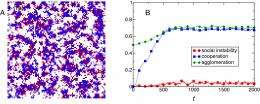July 21, 2011 feature
Cooperation vs. Competition: Greed is good -- but only a moderate amount

(PhysOrg.com) -- Relationships between cooperation, competition, and society have long been pondered by psychologists, sociologists, anthropologists, economists, philosophers, and mathematicians. While (as might be expected) a range of conclusions have been reached, one factor that appears to be essential in achieving and maintaining an equitable distribution of human well-being is social cohesion – that is, a societal infrastructure characterized by high levels of cooperation and a large number of social ties between members of the population. At the same time, however, individual self-interest appears to be inversely related to – and indeed often leads to a breakdown of – social cohesion. As researchers in Switzerland have recently found, however, a moderate level of greed can actually establish a framework in which cooperation and agglomeration (grouping) flourish and societal cohesion prevails.
Dr. Carlos P. Roca and Prof. Dirk Helbing, Chair of Sociology, Modeling and Simulation at ETH Zurich, (Prof. Helbing also of the complexity research-focused Santa Fe Institute in New Mexico), studied a minimalist model of society with very low-information assumptions. In their Public Goods Games-based model, subjects aim to satisfy their aspirations according to a self-interest trait that the researchers call greediness. (Public Goods Games, or PGGs, exemplify the joint but discretionary contribution to a common good.)
One key finding is that Roca and Helbing’s model relies solely on individuals referencing own past experience – a key finding that obviates the variables typically considered in similar research, including greenbeard effects (which would allow subjects to distinguish favorable neighborhoods from unfavorable ones in advance) along with other mechanisms that are known to support cooperation, such as future forecasts, reputation, or punishment.

Addressing the role of greenbeard effects – a process actively debated by evolutionary biologists – Roca points out that these seem to be far less widespread than cooperation. “On the other hand,” he adds, “there is a fairly good agreement now on the fact that stable cooperation requires some kind of cooperator assortment. Many models and mechanisms proposed to date can account for that assortment of cooperators, but they usually imply some identification of others' behavior, which in the end leads to some kind of greenbeard effect. One of the main points of our model is that it can explain cooperation with absolutely no knowledge of others' behavior, so it offers a solution for this issue.”
That said, Roca stresses that their results imply that greenbeard effects are not necessary for cooperation. “People, by observing their own performance instead of others' profits and behavior, can behave cooperatively in an, evolutionarily speaking, successful way. This is of course compatible with the fact that in some particular cases greenbeard effects may exist, and that they can have a role in supporting cooperative behavior – but they do not have to be widespread. In any case,” he points out, “absolute no-exception laws in biology are extremely scarce.”
Roca takes a similar position when considering other factors typically employed in cooperation/competition analysis and prediction. “In my opinion,” he says, “the key factor is the decision protocol followed by individuals. We use a self-referential satisficing model” – i.e., one that determines satisfaction by comparing their payoff with their aspiration level – “which yields completely different collective behavior from the one that is obtained with optimizing or imitative behavior. Cooperation is quite difficult to explain if people are strong optimizers or imitators, but not so much if they look to be satisfied to a certain extent.”
That being said, Roca is quick to point out that models cannot prove themselves more correct or wrong than others in explaining a particular phenomenon. What they do show, he explains, is the logical consequences of some basic assumptions and hypothesis.
“In our case – namely the explanation of cooperative behavior – what we need now is more empirical evidence about the way real people decide when facing social dilemma situations. Very probably, it will turn out that there is not a simple recipe that fits all cases, but that depending on the particular situation and conditions the choice model changes – not to mention that the choice model itself has been subject to evolutionary forces.”
Roca adds that another important point is the relevance of social mobility, that is, the way how people establish and change their social connections. “There are quite some theoretical works available which show its potential importance, but there is much less empirical work about it.”
In terms of applications –for example, government, education and other social programs – Roca feels that it’s a bit too early to speak about practical implications. “We need more empirical evidence for the actual choice model followed by individuals concerning cooperative behavior and social relationships. An important issue here is that experiments done to date invariably show that people are heterogeneous – we all do not decide and behave the same way. On the other hand,” he continues, “it does not seem to be too utopian to dream about a well-designed future survey of a population, group or region which identifies key behavioral factors and which feeds a model with good predictive power. The implications then for designing social programs are obvious.”
An intriguing possibility would be an experiment to determine if the model is applicable to predicting behavior in biological colonies (e.g., bacteria or other single-celled organisms). Roca points out that their model would be determinative for such experiments only if those "individuals" such as single-celled eukaryotes behave in the same way the model posits. “We designed the model with the aim of studying human cooperation and I am not aware of a possible application to the world of microorganisms – but it’s something that I would be very happy to hear about.”
What they actually have in mind, he notes, is behavioral experiments with humans aimed at obtaining empirical evidence along the directions suggested by the model.” In fact, we have recently performed one experiment in the new ETH Decision Science Laboratory (DeSciL), and we’re preparing the paper for submission at this time. We’d be very glad if our paper sparks interest in the community to measure the way humans decide and choose behavior and form social connections.”
Roca’s sees future research into the decision model followed by individuals focusing more on gathering empirical evidence about how real humans decide rather than on designing more complex or more refined models. “In my opinion, from the standpoint of interdisciplinary physics, it is in this cross-feeding between experiments and modeling where the best approach to societal phenomena lies. Depending on what the experiments show we will refine or rebuild the model.”
In the larger context of game theory, risk analysis and forecasting, Roca notes that “game theory, in particular classical game theory, is based on the idea that humans optimize some kind of utility function. Our results prove that if humans behave in a different way, then the emerging collective behavior drastically changes. The implication for game theory and related disciplines is that as long as we want to have correct predictions, we need to make clear the decision model followed by individuals. In the concrete case of cooperation problems, satisficing dynamics plus social mobility theoretically seem to be key factors.”
More information: Emergence of social cohesion in a model society of greedy, mobile individuals, published online before print June 27, 2011, doi:10.1073/pnas.1101044108; PNAS July 12, 2011 vol. 108 no. 28 11370-11374
Copyright 2011 PhysOrg.com.
All rights reserved. This material may not be published, broadcast, rewritten or redistributed in whole or part without the express written permission of PhysOrg.com.
















